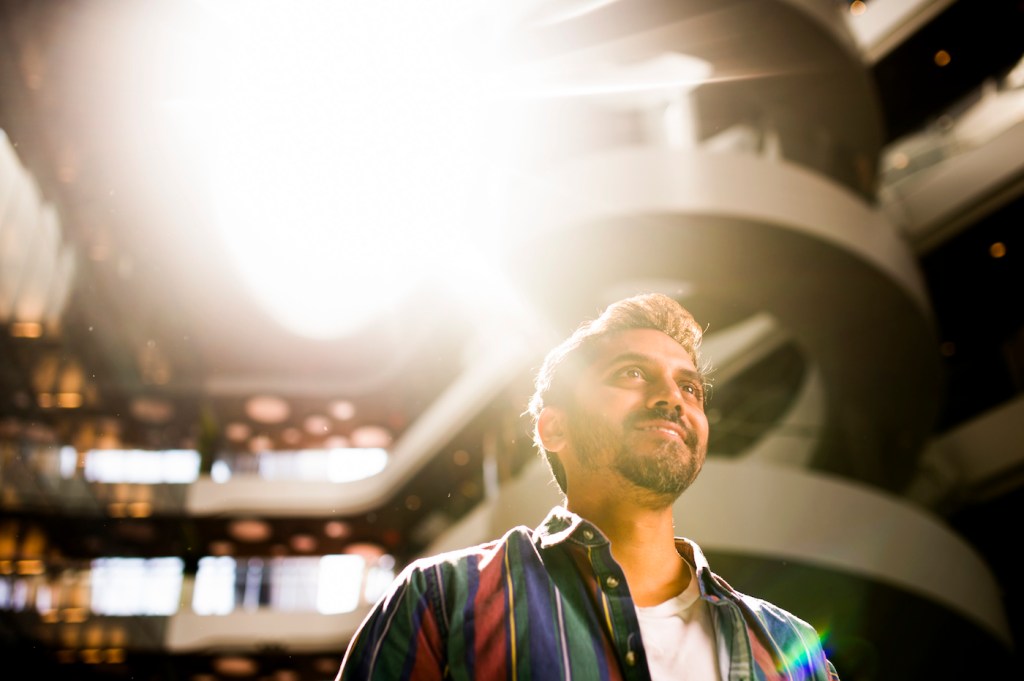Exploring emotion in the brain

Ajay Satpute has always been interested in the mind. Early on, questions of morality and virtue sparked a curiosity in psychology and religion. He also gravitated toward complexity and knew he wanted to study something complicated in an empirical way. And then he found neuroscience.
While attending graduate school at the University of California, Los Angeles and completing post-doctoral research at Columbia University, Satpute honed his research focus. He joined Northeastern as a senior research scientist in 2013, working with Lisa Feldman Barrett in the Interdisciplinary Affective Science Laboratory for more than two years. He left to accept a position at Pomona College in California, and now, three years later, he’s back.
As a social neuroscientist, Satpute is interested in how people perceive emotional states in themselves and others, and whether that understanding can be deepened by knowledge of brain systems. Currently, his main research thrust is connecting subjective experience with neural activity.
To illustrate this concept, he describes two friends playing hooky at the botanical garden.
“If two people say, ‘Wow, I think that’s really beautiful,’ how do they know if they’re experiencing it in the same way? Is it for the same reasons, or not? It could have been the sights for you, it could have been the smells for me, it could be a good memory I retrieved because I’ve been here before. It could just be the simple idea that I’m ditching a work day to go to the botanical garden,” Satpute explained. His work explores whether neuroimaging can help illuminate the origin of subjective experiences.
To understand emotion in the brain, some of Satpute’s research has focused on psycho-physiological interaction, which examines changes in connectivity between brain regions. The standard model for studying these regions divides the brain into about 60,000 different pieces, all of which fall within one of seven networks. But the ways in which these networks interact is less understood.
Satpute was studying brain region connectivity in the context of anxiety, and found that connectivity between two specific regions was greater when someone was in a state of high anxiety than when they were in a state of low anxiety.
“That raised questions for me,” Satpute said. “How can we say there are only seven-ish networks when these brain regions actually change connectivity depending on the state they’re in?”
The spark that drove this inquiry happened in the form of a “miniature ah-ha moment” Satpute had “in that weird conscious state between sleep and wakefulness.” In fact, this is the state in which Satpute has had many ideas over the years. He jots them down in a document he’s been keeping since he was 21 years old, and there are now almost 200 items on the list. That “miniature ah-ha moment” led to a published study suggesting a new way to think about brain networks.
Satpute’s lab at Northeastern conducts a variety of neuroimaging and behavioral studies to better understand emotion and social perception. Another way Satpute has explored human emotion is through theater. This came about in graduate school, when he worked as an instructor and wanted to improve his interactions with students. At the suggestion of a friend, he decided to try acting classes.
“I spent a lot of time doing it—about two years—and every week I was terrified,” Satpute said. But he made it through and achieved the certificate. “It ended up being very informative I think for understanding people both emotionally and socially.”
His acting hobby evolved into a passion for directing—an entirely different perspective on the study of human emotion.
“I loved trying to see how to get people to feel things and produce genuine emotion and feeling on stage—trying to unlock things in people, getting them to different states,” Satpute said.





